
While some industry observers contend that U.S. Space Force's Space and Missile Systems Center (SMC) at Los Angeles AFB, Calif. has moved away from common design criteria for user interfaces (UI) for the Advanced Battle Management System (ABMS), SMC said that such ABMS UIs are a "momentous challenge" and that SMC has such common design criteria, though they are "new and evolving." ABMS is the planned U.S. Air Force and Space Force component of Joint All-Domain Command and Control (JADC2),…














